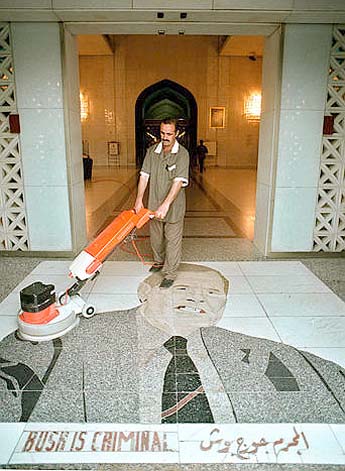Face Off
On August 2, 1990, Iraq, led by dictator Saddam Hussein, invaded neighboring Kuwait. In response, a coalition of forces from the United States, United Kingdom, France, Saudi Arabia, and Kuwait (and about a dozen others) took to arms to help the invaded nation and to repel Hussein. The operation, now known as the Gulf War, resulted in a coalition victory. Iraq left Kuwait and the West imposed a series of sanctions on Hussein’s nation. The coalition lost just under 300 soldiers. The death toll included another 200 Kuwaiti soldiers and 1,000 Kuwaiti civilians. The casualty count was much worse for the Iraqis — an estimated 20,000 to 35,000 people lost their lives in the war.
While the war unofficially ended on February 28, 1991, Operation Desert Storm — the codename for U.S.-led coalition’s war efforts — continued through November of 1995 in order to enforce the sanctions and the establishment of “no-fly zones” in northern and southern Iraq. In late 1992 and into early 1993, for example, Hussein forbid United Nations officials to inspect an Iraqi nuclear power plant. In response, the U.S. launched 46 cruise missiles at the 8-building facility. Coalition forces tried to minimize civilian casualties, but bad, unintended things happen in warfare. Of the 46 missiles launched, “one was apparently struck by Iraqi anti-aircraft fire and crashed into the Al Rasheed Hotel [in Baghdad], killing two civilians,” according to GlobalSecurity.org.
Saddam Hussein responded by erecting a mosaic of U.S. president George H.W. Bush at the bombed hotel.
Bush (the older of the two Bush presidents) wasn’t one of Hussein’s favorite people, of course — Bush was the president who ordered the U.S. into the Gulf War and was still in office when the deflected missile hit the Al Rasheed Hotel. But the mosaic at the Al Rasheed Hotel wasn’t in Bush’s honor. It was an insult, both in words and placement, as seen below (even if it is getting buffed to a good-as-new shine):

The words underneath the portrait of the president read “Bush is Criminal,” which probably tells you all you need to know. But the fact that it’s on the floor is meaningful, too. As Wikipedia explains, “this was intended to force any visitors to walk over his face to enter the hotel (a serious insult in Arab culture).” Much like the time a protester threw a shoe at the younger George Bush, trampling one’s dirty soles on another’s face is a big “screw you” to the intended victim. The placement of the Bush mosaic was designed to make it difficult to avoid trampling over the picture of the American leader; in the decade subsequent to its installation, a number of pro-U.S. diplomats (including at least one American special envoy) walked on Bush.
The Bush portrait is gone, though. During the more recent Iraq War, U.S. troops reached Baghdad. In April of 2003, some soldiers entered the then-uninhabitable Al Rasheed Hotel with hammers and chisels and removed the mosaic from the floor, according to the Associated Press. But they didn’t just leave a gap in the flooring. Instead, they laid a portrait of Saddam Hussein in its place.
Yes, that’s sophomoric, to say the least, but thankfully it was also temporary. In 2008, the U.S. Army Corps of Engineers teamed up with local builders to restore the hotel — without a portrait of either leader — and the Al Rasheed reopened later that year.
Bonus Fact: Saddam Hussein also had portraits of other U.S. leaders hanging around — not presidents, though. He had a fondness for Benjamin Franklin in a way. When American troops raided his palace in 2003, they discovered approximately $650 million in $100 bills hidden in false walls.
From the Archives: Saddam’s Koran: It’s unique. And problematic.
Related: Make your own mosaic stepping stone.
